Bert Cox
Physically Large Apertures for Wireless Power Transfer: Performance and Regulatory Aspects
Mar 09, 2025Abstract:Wireless power transfer (WPT) is a promising service for the Internet of Things, providing a cost-effective and sustainable solution to deploy so-called energy-neutral devices on a massive scale. The power received at the device side decays rapidly with the distance from a conventional transmit antenna with a physically small aperture. New opportunities arise from the transition from conventional far-field beamforming to near-field beam focusing. We argue that a "physically large" aperture, i.e., large w.r.t. the distance to the receiver, enables a power budget that remains practically independent of distance. Distance-dependent array gain patterns allow focusing the power density maximum precisely at the device location, while reducing the power density near the infrastructure. The physical aperture size is a key resource in enabling efficient yet regulatory-compliant WPT. We use real-world measurements to demonstrate that a regulatory-compliant system operating at sub-10GHz frequencies can increase the power received at the device into the milliwatt range. Our empirical demonstration shows that power-optimal near-field beam focusing inherently exploits multipath propagation, yielding both increased WPT efficiency and improved human exposure safety in real-world scenarios.
Experimental Study on the Effect of Synchronization Accuracy for Near-Field RF Wireless Power Transfer in Multi-Antenna Systems
Dec 15, 2024Abstract:Wireless power transfer (WPT) technologies hold promise for enhancing device autonomy, particularly for energy-limited IoT systems. This paper presents experimental results on coherent and non-coherent transmit diversity approaches for WPT, tested in the near field using the Techtile testbed. We demonstrate that a fully synchronized beamfocusing system achieves a 14 dB gain over non-coherent transmission, consistent with the theoretical 14.9 dB gain for a 31-element array. Additionally, phase alignment errors below 20{\deg} result in less than 1 dB of gain loss, while errors exceeding 40{\deg} lead to losses over 3 dB. These findings suggest that phase coherency requirements for WPT can be relaxed, and that scaling the number of antennas is a promising strategy for improving power transfer efficiency.
How to Perform Distributed Precoding to Wirelessly Power Shelf Labels: Signal Processing and Measurements
Aug 20, 2024Abstract:Wireless power transfer (WPT) has garnered increasing attention due to its potential to eliminate device-side batteries. With the advent of (distributed) multiple-input multiple-output (MIMO), radio frequency (RF) WPT has become feasible over extended distances. This study focuses on optimizing the energy delivery to Energy Receivers (ERs) while minimizing system total transmit power. Rather than continuous power delivery, we optimize the precoding weights within specified time slots to meet the energy requirements of the ERs. Both unsynchronized (non-coherent) and synchronized (coherent) systems are evaluated. Our analysis indicates that augmenting the number of antennas and transitioning from an unsynchronized to asynchronized full phase-coherent system substantially enhances system performance. This optimization ensures precise energy delivery, reducing overshoots and overall energy consumption. Experimental validation was conducted using a testbed with84 antennas, validating the trends observed in our numerical simulations.
IoT on the Road to Sustainability: Vehicle or Bandit?
May 31, 2024Abstract:The Internet of Things (IoT) can support the evolution towards a digital and green future. However, the introduction of the technology clearly has in itself a direct adverse ecological impact. This paper assesses this impact at both the IoT-node and at the network side. For the nodes, we show that the electronics production of devices comes with a carbon footprint that can be much higher than during operation phase. We highlight that the inclusion of IoT support in existing cellular networks comes with a significant ecological penalty, raising overall energy consumption by more than 15%. These results call for novel design approaches for the nodes and for early consideration of the support for IoT in future networks. Raising the 'Vehicle or bandit?' question on the nature of IoT in the broader sense of sustainability, we illustrate the need for multidisciplinary cooperation to steer applications in desirable directions.
An Acoustic Simulation Framework to Support Indoor Positioning and Data Driven Signal Processing Assessments
May 04, 2023Abstract:We present an indoor acoustic simulation framework that supports both ultrasonic and audible signaling. The framework opens the opportunity for fast indoor acoustic data generation and positioning development. The improved Pyroomacoustics-based physical model includes both an image-source model (ISM) and ray tracing method to simulate acoustic signaling in geometric spaces that extend typical shoe-box rooms. Moreover, it offers the convenience to facilitate multiple speakers and microphones with different directivity patterns. In addition to temperature and air absorption, the room reverberation is taken into account characterized by the RT60 value or the combination of building materials. Additional noise sources can be added by means of post processing and/or extra speakers. Indoor positioning methods assessed in simulation are compared with real measurements in a testbed, called 'Techtile'. This analysis confirms that the simulation results are close to the measurements and form a realistic representation of the reality. The simulation framework is constructed in a modular way, and parts can be replaced or modified to support different application domains. The code is made available open source.
Techtile: a Flexible Testbed for Distributed Acoustic Indoor Positioning and Sensing
Apr 13, 2022



Abstract:The proposed infrastructure, named Techtile, provides a unique R&D facility as features dispersed electronics enables transmission and capturing of a multitude of signals in 3D. Specific available equipment that enhances the design process from smooth prototyping to a commercial product is discussed. The acoustic parameters of the room, particularly the reverberation and ambient noise, are measured to take these into account for future innovative acoustic indoor positioning and sensing systems. This can have a positive influence on the accuracy and precision. The wooden construction represents an acoustically challenging room for audible sound with a maximum measured RT60 value of 1.17s at 5kHz, while for ultrasound it is rather challenging due to the present ambient noise sources. In general, the Techtile room can be compared with a home or quiet office environment, in terms of sound pressure levels (SPLs). In addition to the acoustic properties, possible research and development options are discussed in combination with the associated challenges. Many of the designs described are available through open source.
Techtile -- Open 6G R&D Testbed for Communication, Positioning, Sensing, WPT and Federated Learning
Feb 09, 2022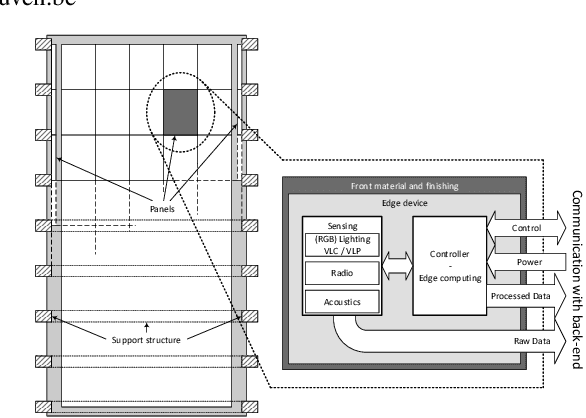
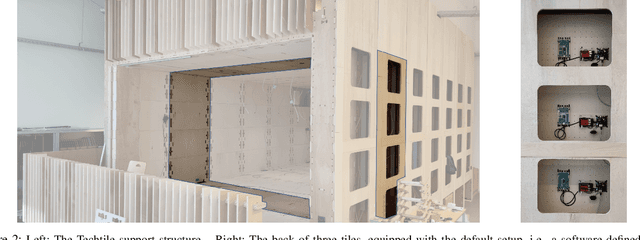
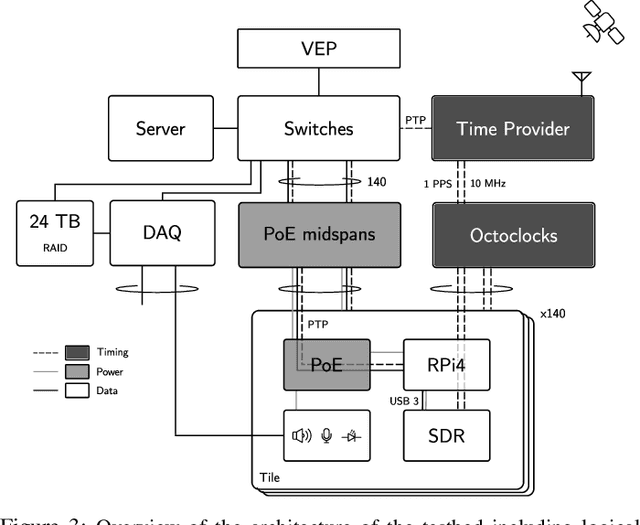
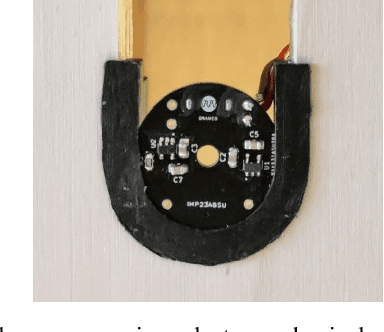
Abstract:New concepts for next-generation wireless systems are being developed. It is expected that these 6G and beyond systems will incorporate more than only communication, but also sensing, positioning, (deep) edge computing, and other services. The discussed measurement facility and approach, named Techtile, is an open, both in design and operation, and unique testbed to evaluate these newly envisioned systems. Techtile is a multi-functional and versatile testbed, providing fine-grained distributed resources for new communication, positioning and sensing technologies. The facility enables experimental research on hyper-connected interactive environments and validation of new algorithms and topologies. The backbone connects 140~resource units equipped with edge computing devices, software-defined radios, sensors, and LED sources. By doing so, different network topologies and local-versus-central computing can be assessed. The introduced diversity of i) the technologies (e.g., RF, acoustics and light), ii) the distributed resources and iii) the interconnectivity allows exploring more degrees and new types of diversity, which can be investigated in this testbed.
A Multi-band Solution for Interacting with Energy-Neutral Devices
Dec 16, 2021
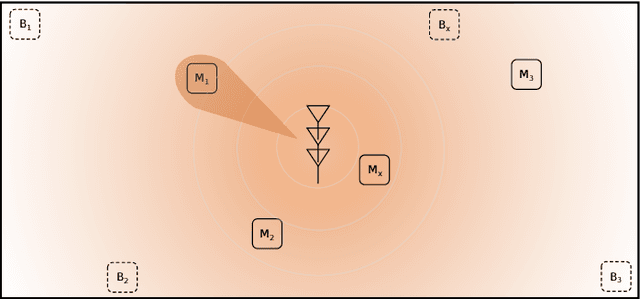
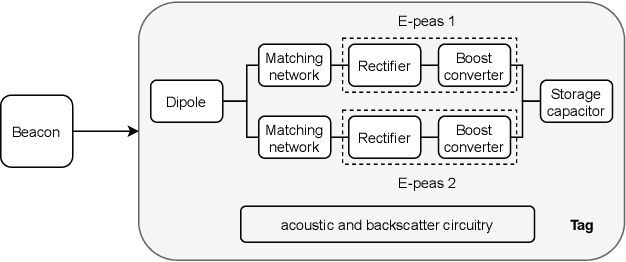
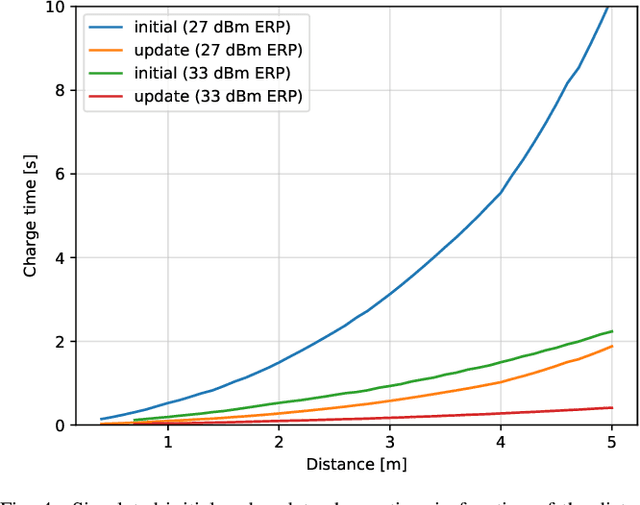
Abstract:RF Wireless Power Transfer (WPT) emerges as a technology for charging autonomous devices, enabling simultaneous power and information transfer. However, with increasing distance, single-input, single-channel rectenna systems are not able to meet the power requirements of large scale IoT applications. In this paper, we tackle this problem on two levels. First, we minimize the energy consumption at the energy-constrained device on three levels. Second, we evolve to a dual-band solution increasing RF WPT. One frequency band is used to provide a base charge to many nodes in a shared transmission. Beam steering, on the other hand, allows for more power hungry operations while introducing as minimal interference as possible. We showcase this method for a hybrid RF-acoustic positioning system. Practical measurements conducted in a multi-antenna indoor testbed (Techtile) show the additional power gain and positioning rate.
 Add to Chrome
Add to Chrome Add to Firefox
Add to Firefox Add to Edge
Add to Edge